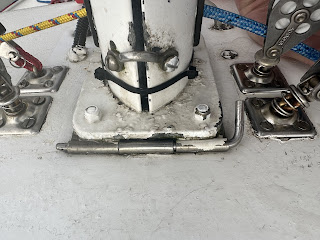Mast Inspection
This winter I’ve learned a few things about the mast on the boat.
The biggest find is that this is probably a mast made by Kenyon. They were more of a teardrop extrusion shape and one of the main suppliers of west coast boats. For reference the mast profile is 4.4 inches x 3 inches, 0.1 inch wall thickness. I say probably made by Kenyon because it doesn’t match exactly the published profiles. It is close though.The spreaders looked like they are missing something. At a minimum the spreader tip should capture the shroud wire so that it cannot fall out of place if sailing in strong winds and the leeward side is slack. That does happen and is a great way to break the mast. The slot on the tip looks like it doesn’t have a good surface for the shroud wire to rest against.
According to the very helpful people at Ballenger Spars this style of spreader tip was found in the 1980’s. It is complete. The shroud wire should be captured in the slot with some stainless steel seizing wire woven through the hole just inside the tip slot. It seems this spreader tip is complete and the seizing wire was not put on some time ago.
This mast has an aftermarket track added to make the mainsail easier to hoist and lower. It is a high density plastic track from Tides Marine. I discovered a few sections of it had obvious UV damage (normal black color bleached to a chalky gray). Long cracks running up and down in those areas. I’ve read online that these mainsail luff tracks will fail by the track peeling apart and mainsail blowing free. Looks like I found it in time. Ordered a new track for around $230 (for 24 feet of track). This track works very nicely and I’ll be very happy to have it still on the boat.
Another area of the mast I’ve learned about are the “Exit Blocks”. These are the cartridge inserts with a built in sheave that are used wherever a halyard or control line goes into or comes out of the mast. On this mast these are all pretty old and almost all need replacement. The rope-and-wire halyards for main and jib also need replacement. I think this is a good opportunity to replace them with dyneema core rope.
That covers the bigger items for the mast. I’ll document the mast step in another post.





I designed a tip for the spreaders and 3D printed them. I will make a new blog entry on them. According to Buzz Ballenger, back in the old days (late 70’s, early 80’s) it wasn’t uncommon for spreader tips to just be plain like I found here. No spreader tips, just the edges of thin aluminum sheet metal to rub against the shroud wires. They did lash the shroud wires onto the spreader with stainless wire though. That was missing here and I’m darn lucky I didn’t have one of them pop off during high winds.
ReplyDelete